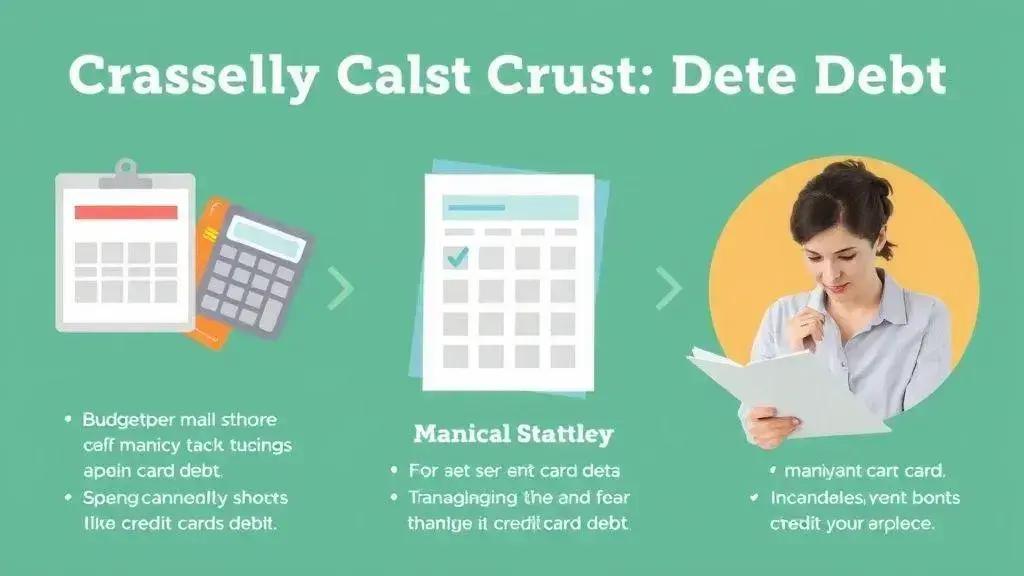Credit card debt reaching new highs: what to know

Credit card debt reaching new highs is primarily driven by rising living costs, high-interest rates, and behavioral factors, leading to significant long-term consequences like lower credit scores and increased financial stress.
Credit card debt reaching new highs is a reality many face today. With rising costs of living and easy access to credit, it’s crucial to understand how this affects your finances. Let’s unpack what this means for you.
Understanding the current credit card debt landscape
Understanding the current credit card debt landscape is essential in today’s economy. Many consumers find themselves grappling with increasing debts that seem unmanageable. This reality impacts not only financial wellbeing but also mental health, relationships, and overall lifestyle choices.
Current Statistics on Credit Card Debt
As of recent reports, credit card debt is at an all-time high, with Americans owing over $1 trillion in credit card balances. This surge can be attributed to various factors such as rising costs of living, increasing interest rates, and easy access to credit lines.
The average American carries a balance of approximately $5,000 on their credit cards. Surprisingly, a significant portion of cardholders pays only the minimum payment, which leads to a cycle of debt that can be hard to escape.
Factors Contributing to Rising Credit Card Debt
- Inflation: Increased costs for essential goods and services are forcing consumers to rely more on credit.
- Low Savings Rates: Many individuals lack sufficient savings, leading them to depend on credit when emergencies arise.
- Psychological Factors: Spending habits greatly influenced by emotional states can lead to excessive use of credit cards.
- Marketing Tactics: The aggressive marketing of credit cards can entice individuals to overspend.
This combination of factors demonstrates a tricky challenge. Navigating this landscape requires knowledge, awareness, and an understanding of personal finance. Recognizing the signs of distress and taking proactive steps is pivotal.
The landscape of credit card debt is constantly evolving. Staying informed about economic trends is beneficial for managing personal finances effectively. By developing smart financial habits, one can begin to reverse the cycle of debt and lead a healthier financial life.
Factors contributing to rising credit card debt
Identifying the factors contributing to rising credit card debt is crucial for understanding how to manage and reduce this debt effectively. Several elements are at play, driving individuals deeper into financial struggles.
Economic Factors
Inflation is a significant force impacting daily expenses. As prices for groceries, housing, and utilities increase, more people turn to credit cards to make ends meet. This reliance can quickly lead to accumulating debt that feels impossible to pay off.
Behavioral Influences
Another factor is the psychological aspect of spending. Many individuals use credit cards to cope with emotional stress or to gain instant gratification from purchases. This pattern can result in overspending, as individuals may not accurately track how much they are charging.
- Impulse Buying: Often triggered by advertisements or emotional states, impulse purchases can boost credit card usage.
- Peer Pressure: Social influences can lead to spending beyond one’s means to keep up with friends or societal expectations.
- Lack of Financial Literacy: Without a basic understanding of managing debt, people may fall into traps that exacerbate their financial situation.
Accessibility of credit also plays a role. With more companies offering credit cards, it’s easy to apply and receive one, which can encourage spending without considering long-term consequences. Additionally, low minimum payments on credit cards may give a false sense of security. Paying just the minimum might keep accounts in good standing but leads to growing balances and high-interest costs.
Understanding these factors allows individuals to take proactive steps. Recognizing personal spending habits can enhance one’s ability to control finances effectively. By acknowledging the external and internal triggers that lead to debt, people can develop healthier financial behaviors.
Strategies to manage and reduce your credit card debt

Managing and reducing credit card debt can feel overwhelming, but there are effective strategies that can help individuals regain control of their finances. It’s important to recognize that taking action is the first step towards financial freedom.
Create a Budget
Establishing a budget is crucial for understanding where your money goes each month. By tracking expenses, you can identify areas to cut back and allocate more funds to pay down debt. A clear budget helps you prioritize essential expenses while finding room to tackle credit card balances.
Prioritize Your Debts
When it comes to paying off credit cards, not all debts are created equal. Consider the interest rates associated with each card. Focus on paying off high-interest debts first while making minimum payments on others. This strategy, known as the avalanche method, saves you money on interest over time.
- Other Options: Alternatively, you can adopt the snowball method, which focuses on paying off the smallest debts first for quick wins.
- This can boost your confidence and motivate you to tackle larger debts.
Additionally, consider negotiating with your credit card company for a lower interest rate. Many companies are willing to work with you if you express your intentions to pay off your debt.
Limit New Purchases
Another effective strategy is to limit new purchases on credit cards. When trying to reduce debt, it’s essential to avoid adding to the existing balances. If possible, use cash or a debit card for purchases until your debt is managed. This helps prevent further accumulation of debt while you work on paying down your balances.
Seek Professional Help
If the debt feels insurmountable, consider seeking help from a financial advisor or credit counseling service. They can provide personalized advice and may help you develop a debt reduction plan. The expertise offered can be invaluable in creating a path towards financial stability.
Ultimately, managing and reducing credit card debt involves discipline, planning, and informed decision-making. By adopting proven strategies, individuals can work towards a debt-free life.
The role of interest rates in credit card debt
The role of interest rates in credit card debt is crucial for understanding how much consumers actually pay for their borrowing. Interest rates can significantly impact the total cost of debt, making it essential to grasp how they work.
Understanding Interest Rates
Interest rates are the costs associated with borrowing money. They are expressed as a percentage of the total amount borrowed and can vary widely between different credit cards. Higher interest rates lead to more expensive debt, as they increase the amount you owe over time.
Impact on Monthly Payments
When carrying a balance on your credit card, interest rates determine your monthly payments. The higher the rate, the more money goes toward interest rather than paying down the principal. For example, with a high-interest rate of 20%, a significant portion of your payment could be spent just on interest.
- Minimum Payments: Many credit cards offer low minimum payment options that may seem affordable but can prolong debt repayment.
- Snowball vs. Avalanche: Understanding the effect of interest can help you choose the right strategy for debt repayment, such as the avalanche method, which targets high-interest debts first.
Moreover, interest rates can be variable or fixed. If a borrower has a variable rate, it may increase over time, making it harder to predict monthly payments. Knowing your credit card’s terms can significantly influence how you manage your balance.
Strategies to Handle Interest
To lessen the impact of high interest rates, consumers can take proactive measures. Consider transferring high-interest balances to a card with a lower rate or a promotional 0% APR offer. This approach can provide a temporary break from accumulating interest, allowing for more effective payment on the principal. Additionally, regularly checking your credit score can help you qualify for better interest rates.
In summary, being aware of how interest rates affect credit card debt is vital for effective financial management. By understanding these rates, consumers can make informed decisions that help in reducing their overall debt burden.
Long-term consequences of high credit card debt
The long-term consequences of high credit card debt can significantly affect an individual’s financial health and overall well-being. Understanding these impacts is essential for making informed decisions about credit.
Credit Score Damage
One of the major long-term effects of carrying high credit card balances is damage to your credit score. A high credit utilization ratio can signal to lenders that you are over-reliant on credit. This can result in lower credit scores, which makes it challenging to secure loans or new credit at favorable terms.
Increased Financial Stress
Carrying a large amount of debt often leads to increased financial stress. The constant worry over repayment can lead to anxiety, sleep disturbances, and strain in personal relationships. This ongoing pressure can have detrimental effects on mental health.
- Potential for Bankruptcy: In severe cases, accumulating debt can lead individuals to consider bankruptcy as a desperate measure.
- Limited Opportunities: High debt can restrict personal choices, such as purchasing a home or pursuing higher education.
- Relationship Strain: Financial stress can lead to disputes among family members or partners, creating tension.
Moreover, long-term high credit card debt can lead to a cycle of borrowing that is difficult to escape. As interest accrues, individuals may rely on new credit to pay down old debt, creating a toxic cycle that deepens financial trouble.
Impacts on Retirement Savings
Another consequence is that high credit card debt can drastically affect retirement savings. Individuals may find themselves diverting funds from savings to cover monthly payments, preventing them from building a secure financial future. This can lead to dependency on social security or family support in later years, which might strain those resources.
In conclusion, understanding the long-term effects of high credit card debt is critical. Recognizing these potential outcomes can motivate individuals to make better financial choices and consider strategies for managing their debts more effectively.
FAQ – Frequently Asked Questions About Credit Card Debt
What are the main factors contributing to high credit card debt?
High credit card debt can result from factors like rising living costs, low savings rates, and impulsive spending habits.
How do interest rates affect my credit card debt?
Higher interest rates increase the overall cost of debt, making it more challenging to pay off balances, as more money goes toward interest.
What strategies can I use to manage my credit card debt?
Effective strategies include creating a budget, prioritizing high-interest debts, and limiting new purchases on credit cards.
What are the long-term consequences of carrying high credit card debt?
Long-term consequences can include damage to your credit score, increased financial stress, and hindered ability to save for future goals.





